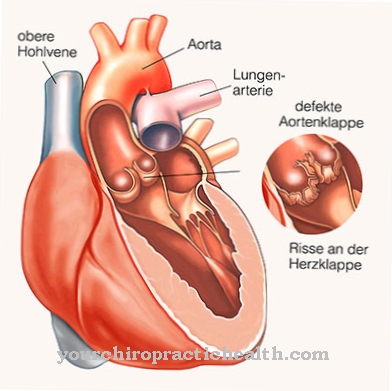If the lactate level in the blood rises, at the same time a decrease in the acid-base balance occurs, the so-called Lactic acidosis. Oxygen deficiency, muscle work or even states of shock, pulmonary embolism and operations can trigger hyperacidity.
What is lactic acidosis?
As part of the Lactic acidosis the lactic acid concentration in the blood increases. The pH value then falls below the physiological range, which also shifts the acidic values. Such a change can have serious consequences. Depending on the cause, the health and life of the person affected can even be endangered.
causes
People with lactic acidosis have too much lactate (lactic acid) in their blood; as a result, acidification occurs. The causes are varied. On the one hand, lactic acidosis can be triggered by medication (e.g. as part of diabetes mellitus treatment); on the other hand, impaired kidney function or liver insufficiency can trigger lactic acidosis. Sepsis (blood poisoning) can also cause lactic acidosis.
Other causes are pulmonary embolism, shock or operations, which can also trigger over-acidification of the body. Lactic acidosis can also occur in extreme athletes if the body has to develop too much muscle strength. That cause, however, is not serious; a break is sufficient for the values to "calm down" again.
Symptoms, ailments & signs

© Lars Zahner - stock.adobe.com
Lactic acidosis can cause different symptoms and ailments. Typical signs are vomiting, nausea, rapid heartbeat, abdominal pain and rapid breathing, fatigue, anxiety, lethargy and weakness. In many cases, an irregular heart rate also occurs.
A classic symptom is Kussmaul breathing. This breathing ensures the compensation in the context of hyperacidity. The "Kussmaul breathing" is characterized by the very deep and regular breathing, whereby the body is busy breathing out the excess acid. Sometimes breathlessness, restlessness and fever can occur. As the disease progresses, confusion, impaired consciousness or even loss of consciousness (coma) are possible.
However, lactic acidosis can have such severe effects on the body and its organs that the acidosis can also lead to death. Especially if the patient is left untreated, there is a risk that the patient will risk his or her life and sometimes die due to lactic acidosis.
Diagnosis & course of disease
The doctor can only diagnose lactic acidosis with a laboratory test. Lactic acidosis occurs when the pH value is below 7.36, while at the same time the concentration of lactate exceeds a value above 5 mmol / l. If the pH value is low and the concentration of lactate is in the normal range, the doctor speaks of metabolic acidosis. No other diagnosis is possible.
The course of lactic acidosis varies. Above all, the cause why lactic acidosis developed plays an important role. If lactic acidosis occurs in extreme athletes, the symptoms subside when the athlete takes a break. However, if organ disorders are responsible for lactic acidosis, especially if the liver and kidneys are affected, there is an acute risk to the patient's life.The patient can fall into a coma; sometimes death of the patient can occur as part of that cause.
Complications
Lactic acidosis causes those affected to suffer from various serious ailments. In the worst case, these complaints can also lead to the patient's death and should therefore be treated in any case. The patients suffer from palpitations and nausea. There is also general weakness and tiredness in the patient.
Lactic acidosis also significantly reduces the patient's resilience. A heart attack or sudden cardiac death can also occur. Unconsciousness or other disorders of consciousness can also occur and significantly reduce the patient's quality of life. There is also an inner restlessness and severe shortness of breath. If lactic acidosis is not treated, the patient usually dies.
Lactic acidosis is usually treated with the help of medication. These can alleviate and reduce the symptoms so that those affected can return to a normal everyday life. As a rule, there are no particular complications. Successful treatment of lactic acidosis will not affect the patient's life expectancy.
When should you go to the doctor?
If various unusual symptoms occur after taking medication or after an operation, a doctor should be consulted. In the event of nausea, vomiting, malaise and abnormalities as well as irregularities in the heart rhythm, a doctor should be consulted. Excessive fatigue, diffuse anxiety, or apathy are signs that need to be investigated. If sweating, internal weakness and loss of appetite occur, a doctor should be consulted. If you have a fever, lethargic behavior or a feeling of illness, a doctor is needed.
Dizziness, unsteady gait, mood swings and an increase in existing discrepancies must be examined by a doctor. A breathing disorder, the feeling of a lack of oxygen in spite of a sufficient supply of fresh air and states of confusion are all warning signs of the organism. In the case of "Kussmaul breathing", the person affected shows a very characteristic sign of lactic acidosis. A doctor's visit is necessary so that a diagnosis can be made after various tests and examinations.
If the symptoms mentioned arise after strong muscle activity, a doctor should be consulted to clarify the cause. If the person concerned suffers loss of consciousness, an emergency doctor must be called as soon as possible. Since failure to treat lactic acidosis can lead to premature death, timely examination of the person affected is advisable. Delays can also result in irreparable organ damage.
Therapy & Treatment
As a rule, lactic acidosis is treated in the hospital (inpatient), with the patient being taken to the intensive care unit. This is because permanent surveillance must be possible until the cycle is stable. In order to lower the acid concentration in the body, doctors also administer bicarbonate as an antidote.
Even if the symptoms of lactic acidosis are primarily treated at the beginning, attention must be paid to which cause is responsible and then treat the triggering factor. The basic / alkaline bicarbonate is administered, which should neutralize the acidification in the body. It is important that lactic acid production is also slowed down or stopped entirely. This is the only way that the body can break down lactate.
It should therefore be ensured that the bicarbonate is used carefully. Sometimes this remedy can also worsen the acidity. If there are signs that the active ingredient is not having the desired effect, therapy must be stopped immediately. As an alternative treatment method - either right at the beginning or after the bicarbonate therapy has not had the desired effect - different fluids can be injected.
These should subsequently improve the oxygen supply of the person affected so that the production of lactate can be counteracted. With oxygen therapy it is possible that the patient is provided with enough oxygen again or that the body of the person concerned can regenerate.
If the lactic acidosis develops due to a diabetic derailment, the patient is injected with insulin. In this way the blood sugar level can be lowered again. Vitamin therapies or even dialysis treatments also cleanse the acidic blood.
However, if the liver is irreversibly damaged so that lactic acidosis was subsequently triggered, only a liver transplant can remedy the situation. In the case of liver damage, only the symptoms are primarily treated; the cause can only be treated when an organ is ready for transplantation.
Outlook & forecast
The course of the disease as well as the prognosis of lactic acidosis depend on the causal disorder. If left untreated and without consulting a doctor, a heart attack or sudden cardiac death can occur if the outcome is unfavorable. If the symptoms occur as a side effect of the administration of medication, a change in the original treatment plan can already result in freedom from symptoms. The drugs prescribed should be checked for their ingredients. Subsequently, alternative preparations are to be determined and used.
Immediately after stopping the triggering medication, the symptoms are alleviated and, in the further course, recovery. If there is an organ disorder, it should be checked how far it has progressed and how severe the damage to the organ is. Usually the organ damage is irreversible and can lead to a loss of organ activity in the event of a severe course of the disease. This represents a potential threat to human life.
For many patients, ultimately only an organ transplant can relieve the symptoms. The procedure is complex and associated with numerous complications. If lactic acidosis occurs in connection with diabetes, the therapy plan must be reviewed. The blood sugar level must be monitored and optimization must take place. The acidification of the blood can be normalized in a dialysis treatment.
prevention
In almost all cases it is possible that lactic acidosis can be prevented. It is important that medication is only taken if the liver and kidneys are fully functional. Taking medication when organs are damaged can inevitably lead to lactic acidosis.
Aftercare
Follow-up measures for lactic acidosis prove to be relatively difficult in most cases, so that a doctor should be consulted quickly in this disease. Self-healing cannot occur and the symptoms of lactic acidosis usually continue to worsen if the disease is not treated properly.
Therefore, the person affected should consult a doctor at the first signs and symptoms. In most cases, those affected are dependent on taking various medications. It is always important to ensure the correct dosage and that the medication is taken regularly. The doctor's instructions should also always be followed. If anything is unclear or if you have any questions, a doctor should be consulted first.
Since most of those affected by lactic acidosis are also dependent on dialysis, help and support from family and friends is often necessary. In many cases, this can also prevent depression or other psychological disorders. Similarly, a healthy lifestyle with a healthy diet has a positive effect on the course of the disease, whereby a nutrition plan can also be drawn up by a doctor.
You can do that yourself
After the lactic acidosis has been treated in intensive care, the patient has to take it easy. Recovery can be supported by monitoring the effectiveness of the prescribed bicarbonate and informing the doctor in the event of unusual symptoms. The active ingredient often does not have the desired effect and then has to be discontinued or adjusted differently. Anyone who experiences side effects and interactions should first write them down in a complaint diary and contact the responsible doctor as soon as possible to discuss further steps.
Finally, the cause of the lactic acidosis must be determined. Often the disease is based on a diabetic derailment, which can be avoided through preparation and changes in lifestyle. In addition, alternative measures such as vitamin therapy are available, some of which are carried out by the patient at home.
If lactic acidosis necessitates a liver transplant, steps must be taken to quickly find a donor organ. To do this, the patient should contact a specialist clinic and at the same time look for a suitable donor from friends or online portals. After a transplant, rest and bed rest again apply. In parallel, the responsible doctor must monitor the state of health.


.jpg)

.jpg)






















